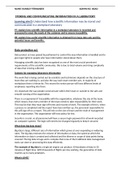NAME: RANSLEY FERNANDES ADMIN NO. 40202
STORING AND COMMUNICATING INFORMATION IN A LABORATORY
Learning aim D: Understand how scientific information may be stored and
communicated in a workplace laboratory
P7: explain how scientific information in a workplace laboratory is recorded and
processed to meet the needs of the customer and to ensure traceability.
P8: explain how useful scientific information is obtained from large data sets and the
potential issues and benefits.
Data protection act
Data protect act was passed by parliament to control the way information is handled and to
give legal rights to people who have information stored about them.
Managing scientific data has been recognised as one of the most crucial prominent
requirements of the scientific community, this is due to total volume and rising complexity
of data that is being collected.
Systems for managing laboratory information
The work that is being carried out by scientists and technicians depends on the structure of
team they are working in, and also the way each team member acts. In majority of
workplaces there is hierarchy. This means the senior person will have different levels of
employees reporting into them.
It is important the way people communicate within their team or outside to the safe and
smooth running of the organisation.
There is a requirement f traceability with the organisation, whatever the size of the team,
which means, that every member of the team needs to take responsibility for their work.
This may be that they must sign off forms and records of work. The example of this is, when
a process is completed and the report have been written up, the personnel responsible for
this will sign off on a report. This will rely on the size of team and the style of management
in the organisation. This organisation will have policy for this.
Security is crucial, so all personnel will have a secure login password for all work recorded
on computer systems. The login will need to be changed regularly to keep it secured.
What does big data mean?
Big data is large, different sets of information which grows at ever-expanding or widening
rates. The big data encloses the volume of information or data, the speed at which the
information or data is created and collected and the diverse or scope of data points being
covered. The big data is huge and is complex that none of the traditional data management
tools can store or processing this data efficiently.
The example of big data is a single jet engine can produce 10+terabytes of data in 30
minutes of flight time. With thousands of flights per day working, the generation of data
reaches up to many petabytes.
What is LIMS?
, NAME: RANSLEY FERNANDES ADMIN NO. 40202
LIMS stands for laboratory information management system. Laboratory information
management system is a software system which is developed to support laboratory
operations. This software system is able to track the specimens and workflows, collect data
for research and make sure that laboratory operations are compliant with different
standards and regulations. the LIMS is made to support laboratory operations. This will
increase operational efficiency of the laboratory by automating and streamlining the
workflows, so less manual job is required.
More than one software can be used. Multiple software can be used for data or sample
management, for keeping track of inventory and orders, data analysis. They can be also
used for data mining and electronic laboratory notebook, processing, and quality control,
reporting and further analysis of data as well as for storage of data. It can also be used
quotation and invoicing or planning.
The LIMS system is able to store text and graphical documents and can use data in order to
supply applicable information, like, the investigation results. the LIMS can also be used to
monitor the good laboratory practice, such as, monitoring the sample collection, testing,
quality assurance and outgoing results.
The system can aware the laboratory of arriving samples so that when they are collected
into the laboratory, they can be bar coded and the devices can be used to generate labels
for quick error-free processing. A hand-held device is used to enter the samples onto the
LIMS. The sample can then be put through the testing procedure with minimum work for
the technical staff.
How is information recorded in a laboratory information system?
A laboratory information system (LIS) is a computer software that processes, stores and
manages data from all stages of medical processes and tests. The physicians and laboratory
technicians use LIS to coordinate varieties of inpatient and outpatient medical testing, which
includes haematology, chemistry, immunology, and microbiology. The basic laboratory
information systems have characteristics which manage patient check in, order entry and
patient demographics. LIS tracks and stores clinical details about a patient during a
laboratory visit and it keeps information stored in the database for the future references.
How is information recorded in a laboratory information management system?
Information can be entered into the LIMS by uploading laboratory instrument generated
files to it, or through registration of samples and creation of text and graphical documents
with information or analysis results. A hand-held device can also be used to enter the
samples and their information onto the management system.
COMPARISON OF STORING DATA BETWEEN COMPUTER AND PAPER
COMPUTER PAPER
Positive Negative Positive Negative
Computer storage It is important to The storing of Storing data
has less fire risk than properly handle data on paper on paper
huge amount of the data or else it are cheap and it require more
paper. can cause trouble. is easy to storage space.
It is easy and quick It is essential to produce. The data
to search for have user-id and Stored data on stored on




